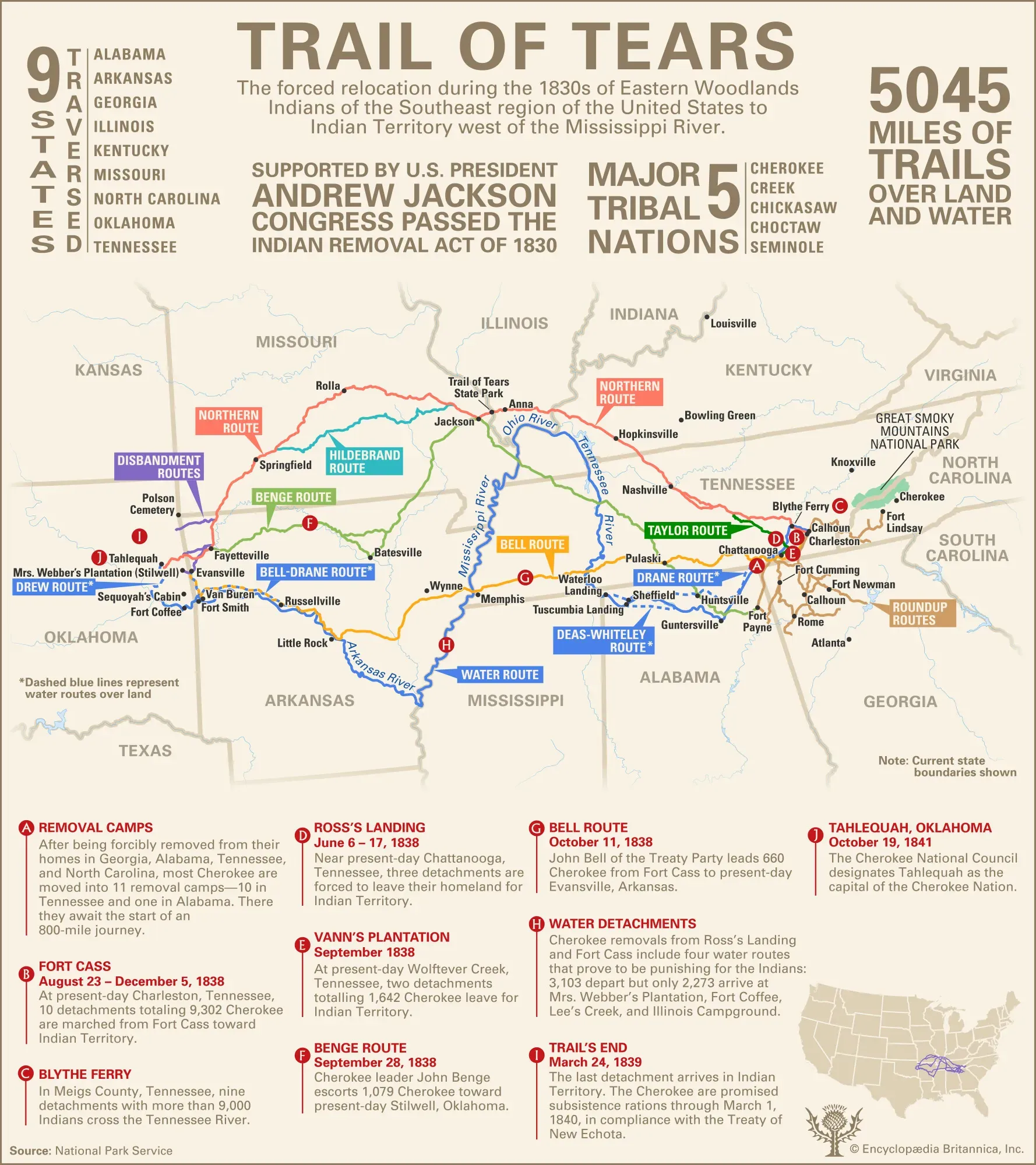Trail of Tears: Routes, Statistics, and Notable Events
The Trail of Tears refers to the forced relocation of Native American tribes, including the Cherokee, Creek, Choctaw, Chickasaw, and Seminole, from their ancestral lands in the southeastern United States to designated Indian Territory west of the Mississippi River. This tragic journey, which took place between 1830 and 1850, resulted in the deaths of thousands due to harsh conditions, disease, and starvation. Notable events include the Cherokee Nation's legal battles and the infamous 1838-1839 Cherokee removal.

The ''Trail of Tears'' is a significant historical event that highlights the forced relocation of Native American tribes from their ancestral homelands in the southeastern United States to designated Indian Territory west of the Mississippi River. This tragic journey is characterized by suffering, hardship, and loss, and it is essential to understand the various ''routes'', ''statistics'', and ''notable events'' associated with it.
Routes of the Trail of Tears
The ''Trail of Tears'' encompassed multiple routes taken by different tribes, primarily the ''Cherokee'', ''Chickasaw'', ''Choctaw'', ''Creek'', and ''Seminole'' nations. The pathways varied based on the tribe’s origin and destination, but they all shared the common theme of hardship and suffering. Below is an overview of the primary routes taken during this tragic relocation:
| Tribe | Starting Point | Destination | Route Details |
|---|---|---|---|
| Cherokee | North Carolina, Georgia, Tennessee | Oklahoma | Approximately 1,000 miles through rugged terrain |
| Choctaw | Mississippi | Oklahoma | First major removal in 1831, over 500 miles |
| Creek | Georgia, Alabama | Oklahoma | Forced march in 1836, roughly 1,000 miles |
| Chickasaw | Mississippi | Oklahoma | Relocation in the late 1830s, around 500 miles |
| Seminole | Florida | Oklahoma | Multiple conflicts led to removal in the 1830s, 1,200 miles |
Statistics of the Trail of Tears
The ''Trail of Tears'' was marked by devastating loss and hardship for the tribes involved. Here are some key statistics that illustrate the impact of this forced relocation:
| Statistic | Number |
|---|---|
| Estimated Cherokee population before removal | Approximately 17,000 |
| Estimated Cherokee who died during the journey | 4,000 |
| Years of significant removal (1830-1850) | 20 years |
| Total distance traveled by the Cherokee | 1,000 miles |
| Major tribes affected by the relocation | Five Tribes |
Notable Events During the Trail of Tears
Several significant events occurred during the ''Trail of Tears'', each contributing to the narrative of suffering and resilience among Native American tribes. Some of these notable events include:
The Indian Removal Act of 1830
President ''Andrew Jackson'' signed the ''Indian Removal Act'', which facilitated the forced relocation of Native American tribes from their lands in the Southeast to areas west of the Mississippi River. This act was a pivotal moment that set the stage for the subsequent removals.
The Treaty of New Echota
In 1835, a small faction of the ''Cherokee'' signed the ''Treaty of New Echota'', which ceded Cherokee land to the U.S. government in exchange for compensation and land in the west. Many Cherokees opposed the treaty, leading to divisions within the tribe.
Forced Marches Begin
In 1838, the U.S. government began the forced removal of the ''Cherokee Nation''. Thousands were rounded up and forced to march under harsh conditions. This beginning of the march marked the start of the tragic journey that would come to be known as the ''Trail of Tears''.
Public Awareness and Legacy
The suffering endured during the ''Trail of Tears'' eventually drew public attention and criticism. Over the years, it has been recognized as a symbol of the injustices faced by Native Americans, leading to discussions about reparations and the preservation of Native American rights and heritage.
Conclusion
The ''Trail of Tears'' remains a poignant chapter in American history, representing the resilience of Native American tribes in the face of adversity. Understanding the routes taken, the statistics that highlight the scale of the tragedy, and the notable events that shaped this period is crucial for acknowledging the past and fostering a dialogue about the rights and recognition of Indigenous peoples today. By studying this dark history, we can work towards a more just and equitable future for all.












